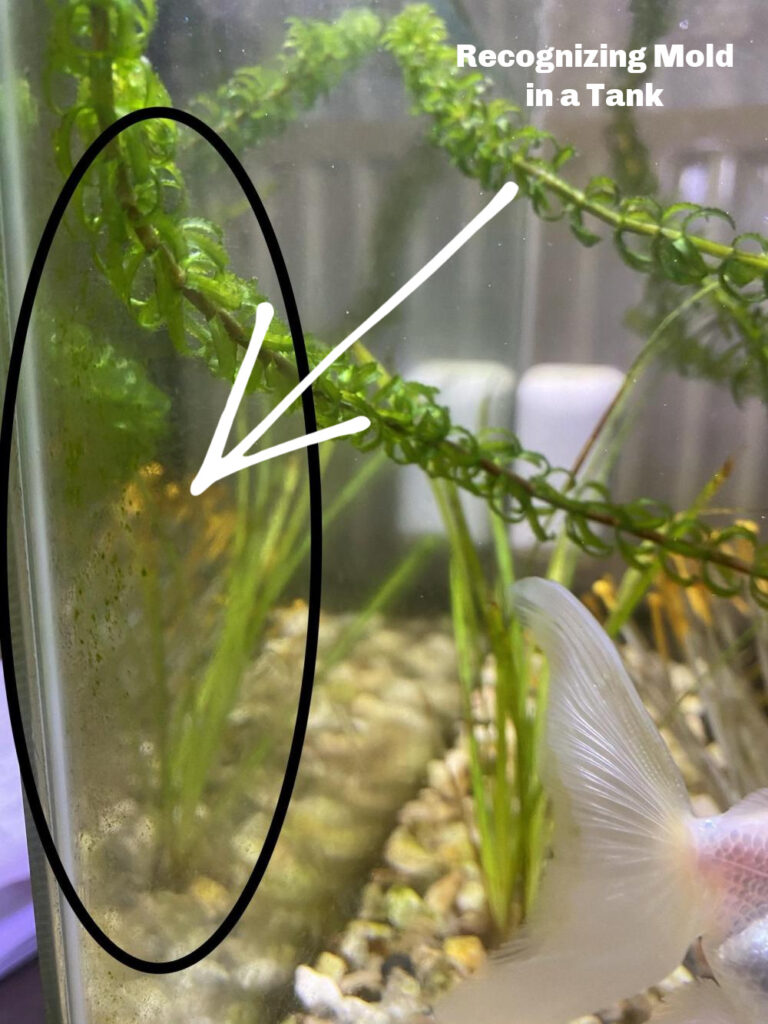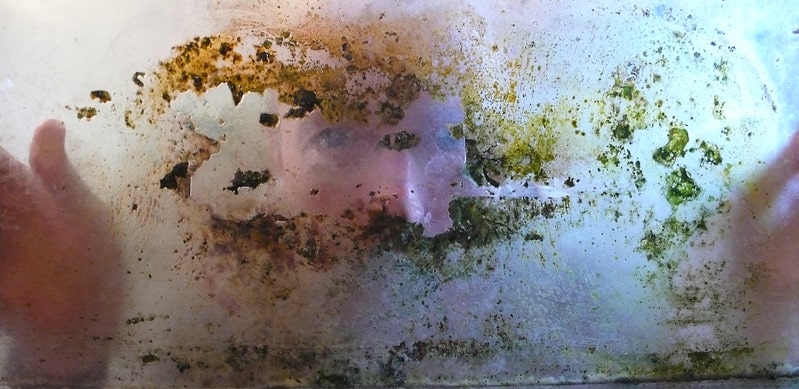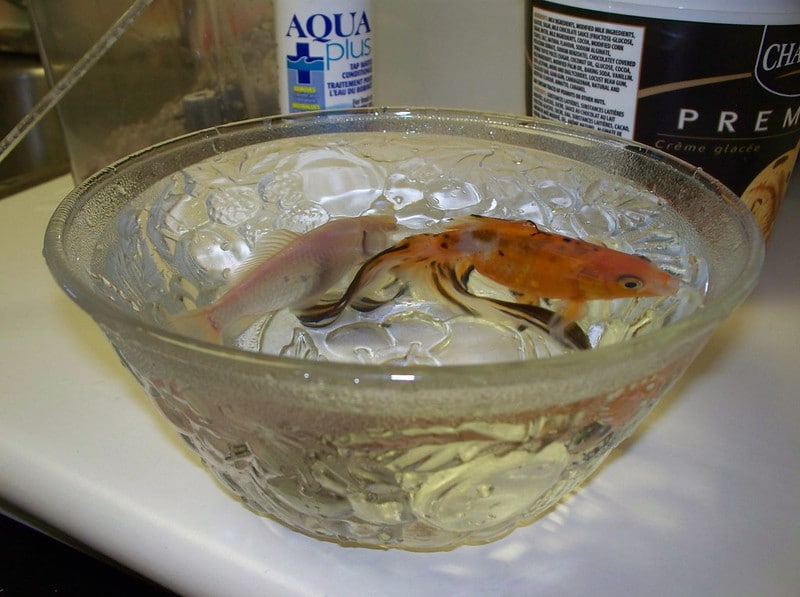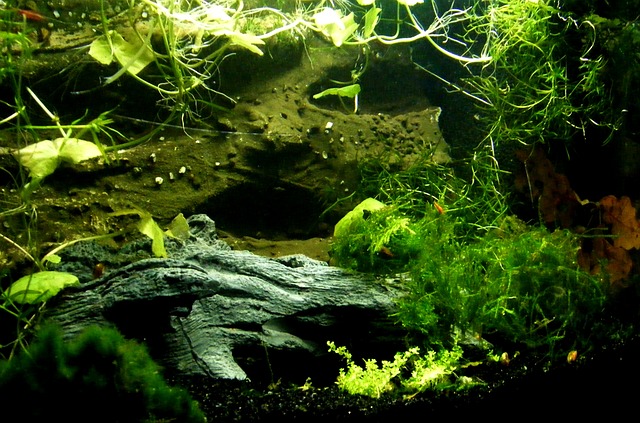How To Remove Mold From Aquarium
BuildYourAquarium.com is supported by our readers. When you purchase through links on our site, we may earn a commission. Acquire more.
No one likes seeing a cloudy fish tank. Routine cleaning and hygiene should forestall such a sight. But sometimes that green moving-picture show covering everything from the sides of the tank to the décor? It isn't what you think.
Mold can notice its way into a fish tank with footling trouble. And removing mold – especially once it'southward grown out of command – is an undertaking. But fish tank mold is harmful – to your fish AND you.
Quick Links
- ane Fish Tank Mold
- i.1 Recognizing Mold in a Tank
- ane.2 Consequences of Mold
- 2 Removing Fish Tank Mold
- 2.1 Supplies for Mold Removal
- 2.2 Safety First
- 2.3 Your Fish
- 2.4 Step ane: The Lid
- two.five Stride 2: The Tank
- 2.six Step 3: Décor
- two.7 Step 4: Revisiting the Tank
- two.8 Stride v: Clean-Up
- iii Preventing Fish Tank Mold
- iv Frequently Asked Questions Near Fish Tank Mold
- 4.ane Are At that place Unlike Kinds of Fish Tank Mold?
- 4.2 Is Mold the Same equally Algae?
- 4.3 Should I Change My Tank's Filter?
- 4.iv Can I Use Cleaning Products?
- 5 Unwanted Fungus
Fish Tank Mold
People don't often remember of mold as popping up in fish tanks. On ancient leftovers in the fridge, sure. But in a fish tank? That seems foreign.
But why? Mold is nix more than a fungus. And fungi but need a few things to grow:
- Moisture
- Calorie-free
- Sustenance
You tin find all of those things in a fish tank. That goes double when the cleaning schedule'southward fallen behind, or fish have received too much food. Waste product builds up in the system, giving mold a chance to spread. And in a fish tank, you have the unique status of underwater AND airborne fungus in ane handy location.
Recognizing Mold in a Tank

Aquarists may overlook mold in their fish tank, specially green mold. The fungus looks similar to algae. (Non that algae are a favorite to take effectually in a tank, either) But you'll detect subtle differences emerge as the mold makes itself at home.
That greenish moving picture doesn't confine itself to the tank sides. It slowly spreads over the glass, the substrate and even attaches itself to your fish. You'll discover the mold below AND above the water clinging to the underside of your aquarium hat. It oftentimes takes on a fuzzy texture – precisely similar the mold yous wrinkle your nose at when you open the fridge.
And if it's crawling beyond the hat? Yous're already breathing in the spores it'south sending out into the room. (Something fun to contemplate)

Consequences of Mold
Mold, on its ain, is unattractive in a fish tank. It covers the drinking glass, obscuring the view. And all of your décor? It starts to look ugly.
But fish tank mold is also harmful. If you neglect to accost the fungus spreading throughout the aquarium, your fish can end up with several infections. Mold can attach to fish and invertebrates. Every bit they're already under stress from the poor h2o quality, they have lower amnesty. And the outcome?
- Cotton fiber illness
- Fin rot
- Gill rot
- Mouth rot
As the fungal infections continue, secondary diseases go to work. And before long, your fish begin to die.
Removing Fish Tank Mold
Preventing fish tank mold from actualization is the best grade of action. Simply it's also a natural part of the aquatic world. This means you're going to see mold now and and so. So it'south essential to understand how to remove mold as soon as y'all spot information technology.
And this goes double if you purchased an aquarium from someone else. Mold spores can happily lay dormant on glass, tucked away in the corners. Earlier you start to fix your tank, follow the same steps you would for mold removal. It'll save you pain and heartbreak down the route.
Supplies for Mold Removal
Fish tank removal requires some essential supplies. Before y'all start, make sure yous take all of the post-obit:
- Vinegar
- Hot h2o
- Sponges
- Toothbrushes (preferably not one you're currently using)
- Paper towels
- Siphon
- Glass scraper
- Bucket
- Colander
Safety First
Mold – fifty-fifty fish tank mold – is harmful to humans. It can pb to respiratory bug. So whenever you're dealing with a fish tank mold removal process, yous must wear a mask.
This will protect you during the cleaning. Y'all'll likewise desire to wash your hands as often as possible. (If you impact anything y'all doubtable is mold? Reach for the soap) And don't wearable wearing apparel y'all're attached to. Retrieve, mold spores are sneaky, and they like to attach themselves ANYWHERE.

Your Fish
Fish tank mold removal is a brutal undertaking. You may need to remove over l% of the h2o from the tank – and that's for a MILD problem. (For severe infestations, the entire tank gets drained) As such, you don't want to daze your fish. You'll need a separate container with Make clean h2o. Make sure information technology matches the tank'south water conditions. It'south also a good idea to keep it in a different room from where you're cleaning.
Pace 1: The Lid
Fish tank mold has a weakness: vinegar. So you're going to desire to prepare a solution of one part vinegar to one part (clean) h2o. Putting the solution in a spray bottle will make it easier to piece of work with.
- Remove the lid and set it on a surface covered with paper towels.
- Spray the hat, scrubbing the mold (You tin can use a sponge or toothbrush).
- Rinse the chapeau with hot h2o.
- Spray the lid with the vinegar solution again. This time, allow it sit down for 2 minutes.
- Repeat the scrubbing process.
- Rinse with hot water until you tin can no longer smell the vinegar.
- Leave to air-dry.
Step 2: The Tank
Vinegar is fine for the OUTSIDE of the aquarium, but you don't want it on the inside. Information technology's acidic and volition drop your water's pH too low. Be careful with that spray bottle.
- Drain the water with your siphon. If the fish tank mold's bad, empty the unabridged tank.
- Empty the water Outside and as far from the house as possible.
- Scrub the glass with your grass scraper (and lots of elbow grease).
- If you need, break out a fresh toothbrush to get into those corners. (Recall, no vinegar goes inside)
- Rinse the tank with hot water. Continue until the siphon runs articulate.
- Rinse out your filter with hot h2o, throwing away the old cartridge.
- Spray the Outside of the tank with the vinegar solution and wipe it downward.
- Leave the tank to air-dry.
Step iii: Décor
Rocks, gravel, and plants volition return to the tank once make clean. This means you lot can't apply vinegar. (And vinegar will kill live plants) Try to separate your substrate from the rest of the decorative pieces.
- Submerge everything in hot water. (If you tin can manage it, employ boiling water) Leave it for 5 minutes.
- CAREFULLY (no burns), scrub everything with a toothbrush that HASN'T touched vinegar. Gravel can get stirred around to loosen mold particles.
- Rinse everything with fresh hot water and the colander.
- Continue the scrubbing and rinsing until the water runs clear.
- If you lot have items that can survive the procedure, boil them for 2 minutes equally an extra sterilization procedure.
- Spread everything on CLEAN paper towels to air-dry.
Step 4: Revisiting the Tank
Mold creates spores, and it clings to glass and corners. You'll want to give your aquarium a second thorough cleaning before you lot kickoff to reassemble everything.
- Break out the drinking glass scraper ane more time to ensure you've removed EVERY bit of mold.
- Use the toothbrush to reach those pesky corners.
- Rinse down the tank with hot h2o, making sure the siphon runs clear.
- Set up a new filter cartridge in your organization.
- Return the substrate and décor to the tank.
- Make full the tank with Make clean water. Brand sure you use your usual dechlorinator and h2o clarifiers.
- Test your h2o quality.
- Gently return your fish to their mold-costless tank.
Step 5: Clean-Up
At that place's a good chance yous have mold spores fastened to the tools y'all scrubbed with. With UNDILUTED vinegar, rinse everything thoroughly. And then rinse them over again with hot water. If the h2o looks cloudy, repeat the process until it rinses make clean.
For the toothbrushes and sponges, consider throwing them abroad and buying replacements. They take crevices and bristles where spores may hibernate. And y'all don't want to risk introducing mold to your fish tank the next time you clean.
Preventing Fish Tank Mold

Now that you accept a sleek, shiny, mold-gratis fish tank, you want to go along things that way. And so how do you proceed mold out of your aquarium? Mold grows where there'due south excess waste in a system. This means tanks with poor water quality, untended filters, and overfeeding. Simply other problems also contribute to mold problems in a fish tank:
- Plants: Live plants assistance the nitrogen wheel. They too supplement the diet of some fish. But they're challenging to manage. If you lot don't replace your plants every few weeks, they decay. That feeds directly into mold growth.
- Light: One of the disquisitional components for fish tank mold is light. And sunlight? It's the best. Fish tanks placed close to direct sunlight oft struggle with outbreaks of mold. You lot'll see the fungus starting in the corners of the tank closest to the sun and moving downward. Yous desire to avoid natural sunlight every bit much as possible.
If yous want to cut down on the risks of mold, you demand to go along your aquarium make clean at ALL times. This ways performing weekly water changes. SOME fungus in the water is benign to the nitrogen bicycle. The fungal cells work with the bacteria to continue your fish and plants healthy. But y'all don't want things to slide out of control.
You should also but feed your fish the amount of food they can eat within 15 MINUTES. If you run into leftovers hanging effectually, it's time to cutting back. The excess particles of food make the water cloudy and feed mold growth. Plus, those leftovers are your fish letting y'all know they're full.
Oft Asked Questions About Fish Tank Mold
Are In that location Different Kinds of Fish Tank Mold?
Yous tend to see three types of mold in a fish tank:
- Dark-green mold: This green film is ofttimes mistaken for algae in the average fish tank.
- White mold: White fungus can start dark-green before turning brownish and then irresolute to a white color. Information technology leads to the most health issues in fish.
- Black mold: Black mold is rare, but it thrives when you have backlog decomposition present.
All of them arise from poor h2o quality and too much waste in the aquarium environs. And cleaning them? You use the same process.
Is Mold the Same every bit Algae?
Mold and algae come from different families. And while they use the same resources, they don't bear the aforementioned. No one enjoys fighting algae blooms in their fish tank, merely you have plenty of resources available to combat the problem:
- Algae-eaters
- LED lights designed to limit algae growth
- Nitrate removers
When it comes to mold, those solutions aren't effective. Though, of course, managing your cleaning schedule and limiting the waste matter yous let will help with algae OR fish tank mold.
Should I Change My Tank'south Filter?
If you're finding mold in your fish tank – peculiarly later performing a thorough cleaning, you need to consider a filter change. The ability in your filter may not be stiff enough to cope with the stock in your tank.
Remember, the filter needs to handle EVERYTHING in your tank: fish, plants, and invertebrates. And while the power listed may work for your tank size, it may end upwardly struggling to continue up with the bioload. Canister filters have the most power. Then if y'all run across fish tank mold, y'all may want to consider an upgrade.
Tin I Employ Cleaning Products?
The problem with cleaning products in mold removal is the chance they pose to your fish and other tank residents. Fifty-fifty with thorough rinses, residuum can hang around. The chemicals in cleaning products AREN'T approved for fish. Even the diluted vinegar is also strong and can lead to problems with the water values.
You're meliorate off sticking to hot water and elbow grease. You'll keep your fish condom. It requires more work, but at least you won't risk fish getting ill or dying as a effect.
Unwanted Fungus
Every cycled fish tank contains SOME fungal components. But fish tank mold? That's disgusting, and no one likes seeing information technology creep over the drinking glass sides and lid.
You need to wait over your maintenance to see if you tin make improvements. And and so yous can perform a thorough fish tank mold removal. With some work, a clear, shiny, mold-free aquarium IS possible.
And your fish will remain safety and good for you – with no fuzzy fungus invaders.
Resources:
- Aquarium Science – link
- MoldBlogger – link
Source: https://www.buildyouraquarium.com/fish-tank-mold/


0 Response to "How To Remove Mold From Aquarium"
Post a Comment